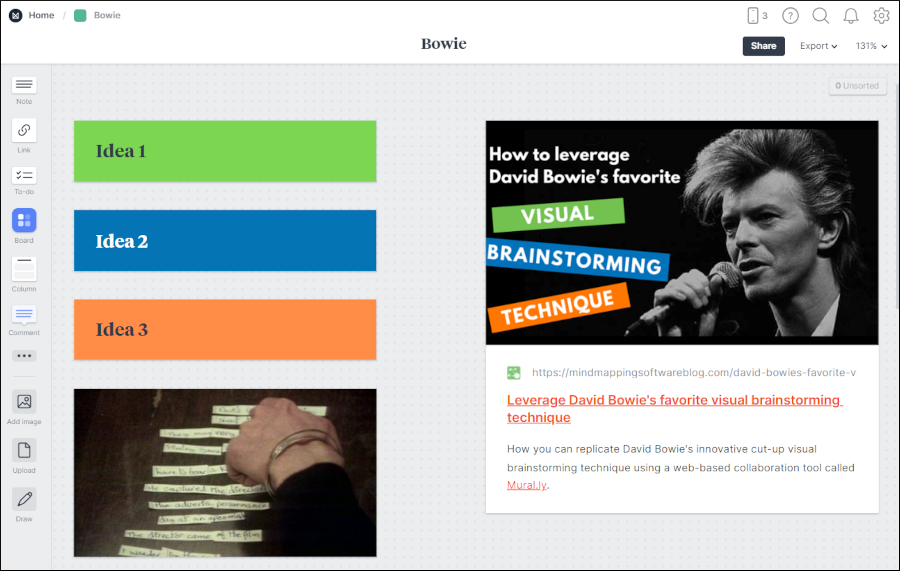
One of the visual brainstorming techniques the late David Bowie used to inspire unique songs and lyrics was to randomly arrange newspaper and magazine headlines and other short bits of text as catalysts for ideas. You can do the same thing today using a visual thinking tool called Milanote.
 This “cut-up technique” was developed by artist Brion Gysin in 1959, when he adapted the montage art technique to printed words in an attempt to modernize the craft of creative writing. Its biggest proponent was American novelist William S. Burroughs, who further refined and popularized this type of visual brainstorming.
This “cut-up technique” was developed by artist Brion Gysin in 1959, when he adapted the montage art technique to printed words in an attempt to modernize the craft of creative writing. Its biggest proponent was American novelist William S. Burroughs, who further refined and popularized this type of visual brainstorming.
Here’s how it works: First, you cut headlines or phrases of text from newspapers and magazines. You can also use hand-written text, as shown above right. These become the catalysts for your brainstorming. You then move these strips into random combinations on a flat surface, and make notes on the creative ideas they suggest.
How to create a digital version of this visual brainstorming technique
To bring the cut-up technique into the digital age, I recommend using a visual note-taking tool. Because inspiration can come from anywhere, it’s important to use a tool that enables you to drag and drop inspiring content into its visual canvas – such as words and phrases, images and web page links – in addition to opening a new card in the app and typing into it.
Since we’re going to be capturing fairly short bits of text, it’s also vital that the application is able to display them at a decent font size.
I tried several visual note-taking tools, but discovered that they’re optimized for creating longer notes, not brief chunks of text. They also didn’t support the action of dragging and dropping content onto a blank area of the canvas. They required me to first create a blank note before I could drag and drop content into it.
I finally selected Milanote, which is more of a creative moodboard tool. In other words, it’s optimized to add bits and pieces of inspiration to a visual workspace.
As you can see from the screenshot below, I was able to easily drag and drop elements from this blog post into a board, including:
- An image
- A link
- A text snippet
I also created 3 new cards called “Idea 1-3.” I was able to easily format their text using Milanote’s “large heading” style and change their colors to mimic the horizontal strips in the blog post image.

You can then move, resize and link them to meet your needs.
How can you use this technique for visual brainstorming?
Here are some ways you can use this brainstorming method to develop new ideas:
- Gather a random assortment of images and text – including thought provoking quotes and your own insights, ideas and experiences. One of the techniques Bowie used, for example, was to cut up samples of text from his personal journals. This helped to ensure that some of the creative stimuli he was using was drawn from his own thoughts, insights and experiences.
- Insert words designed to help you think of your challenge from multiple perspectives, such as the idea modification words that make up the SCAMPER mnemonic.
- If you’re brainstorming with a team, give each team member a keyword and ask them to perform a Google image search on it and select 10 images to add to a shared board. This should widen the diversity of images you have to use as fodder for ideation.
- Do a team brainstorming session consisting of text input via notecards only. Let your team members know that they would free associate with their term on their own. After they have added their ideas to a shared board, they should then view the ideas submitted by their colleagues, with a goal of using them as stepping stones to additional ideas.
- Use color coding to visually classify ideas.
- When you’re done brainstorming, gather related ideas together, such as those that are worthy of further consideration or those you plan to implement.
Why not give David Bowie’s cut-up technique a chance using Milanote? I predict you’ll be pleasantly surprised by the results, as I was.

Leave a Reply